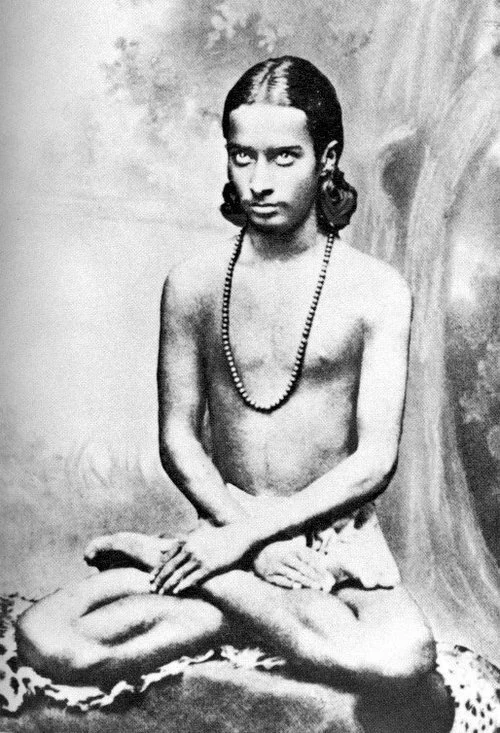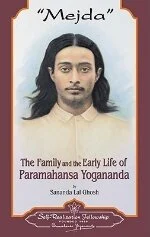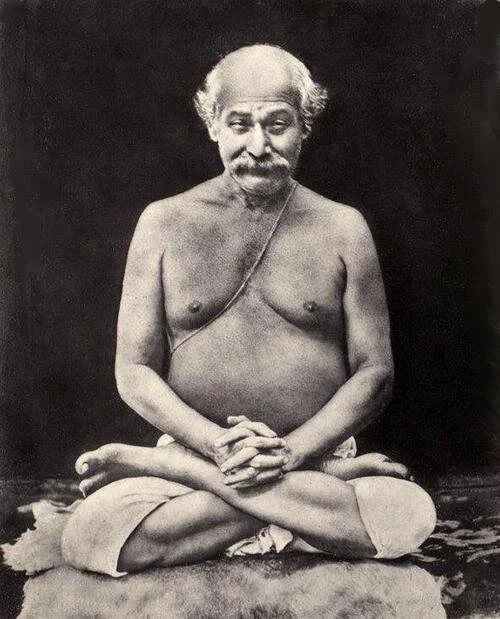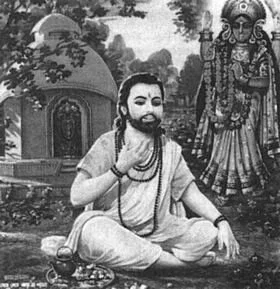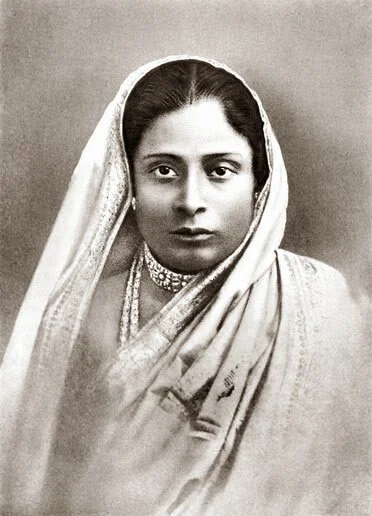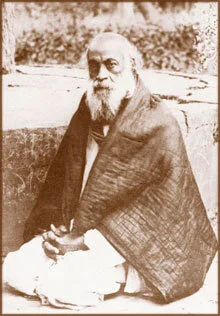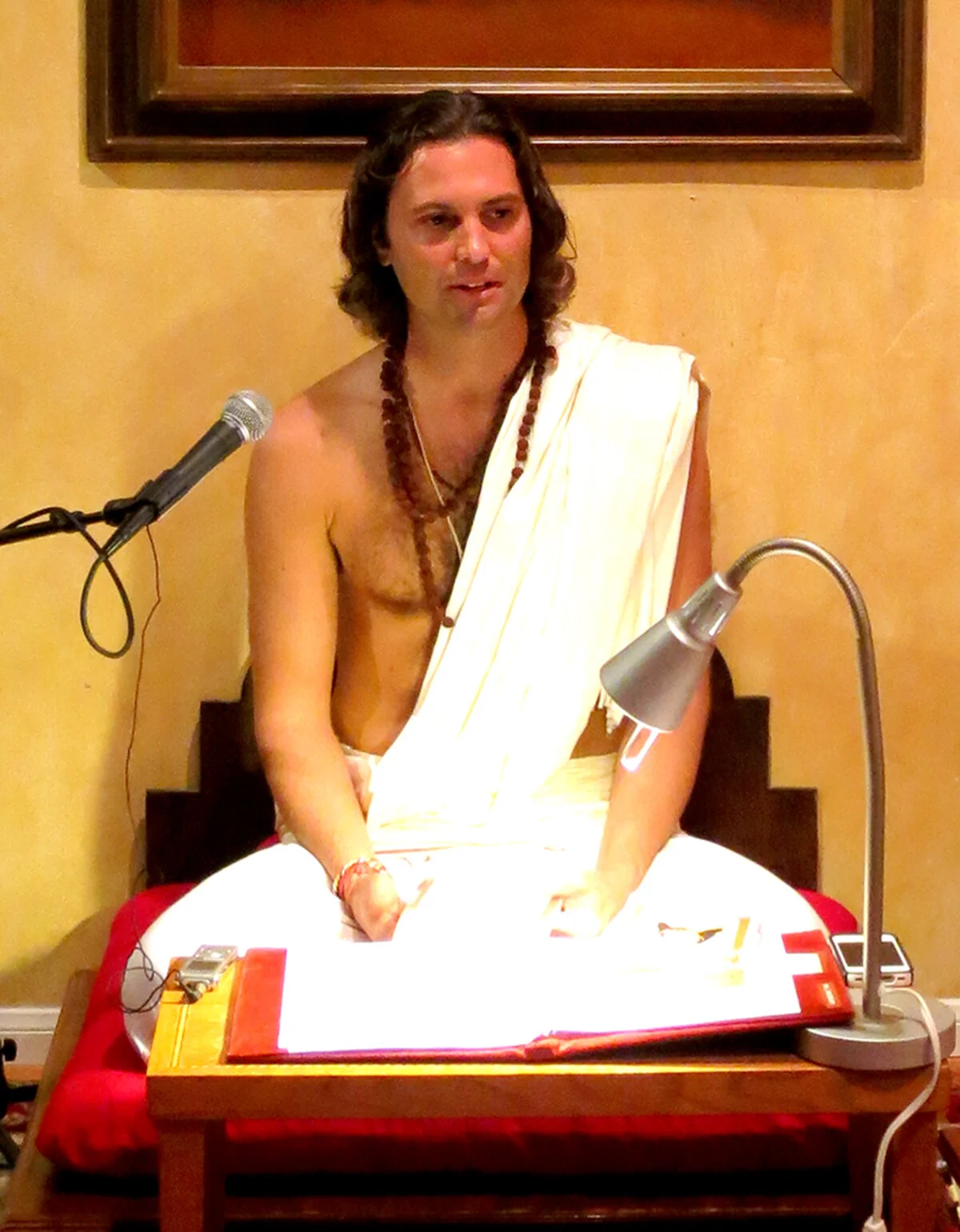Paramahansa Yogananda and Divine Mother Kali
Naren K. Schreiner (Kamalakanta) gave a discourse at the Kali Mandir in Laguna Beach on Paramahansa Yogananda and his intimate and profound relationship with the Divine Mother, Goddess Kali. A recording of the entire talk, given on February 15, 2014, is below. A written transcript was published as a 3-part series in the Himalayan Heritage, a publication dedicated to Sanatana Dharma (India's ancient sacred tradition). The following article is Part I, here published courtesy of the Himalayan Heritage, with pictures added by Sangita Yoga. First published June 2014.
The complete talk is available in the player below, to stream or download.
If you wish, click "Download" on the player to save it to your device.
But be sure to see the photos in the article!
If you prefer iTunes podcast, it is available on Kali Mandir Satsang, talk No. 92
Paramahansa Yogananda and Mother Kali, Part I
Brahmanandam Paramasukhadam Kevalam Jnana Murtim
Dwandwatitam Gagana Sadrisham Tattwamasyadi Laksham
Ekam Nityam Vimalam Achalam Sarvadhi Sakshi Bhutam
Bhavatitam Triguna Rahitam Satgurum Tam Namaami
It is such a privilege to be here in Ma’s presence at Kali Mandir, in the presence of Usha Ma, Swami Ambikanandaji and all of you. [Swami Bhajanananda was away in India] From my elders I request permission to begin. I feel very blessed to be here.
In my youth I had the great blessing to be exposed to Paramahansa Yogananda and his teachings. When I was very young, my father went to the Lake Shrine, one of Yoganandaji’s beautiful centers in Los Angeles. There are many centers including one in Encinitas. Some of you may know of them. My father became a disciple and began to meditate. So I had exposure from a young age. It is unusual for an American to have that.
As I got older I heard more and more stories about Yoganandaji, saw his beautiful pictures, and read his writings. I too felt very drawn to follow his teachings and become his disciple. As time went on, I wanted to know, “Who was Yogananda?” I joined his ashram when I was 18, and had the desire to be a monk, a brahmachari, in the Self-Realization Fellowship ashram. In India SRF is known as Yogoda Satsanga Society. I realized that though I had so much access to his teachings, his pictures and so on – so many wonderful stories, I felt something was missing. I felt like a child who was being told who his father was without meeting his father in person. I read his words yet I wanted to know what was in his heart of hearts. I was searching for what made him who he is.
Mukunda at age 16.
I want to show you this picture because it had a great impact on me. It is Yoganandaji when he was 16. I was also 16 when I read his book and began practicing his sadhana. I used to look at this picture and think, “If only I could be with him when he was 16; if I could be one of his disciples at that time of his life when he was doing his sadhana.” I wanted to know more about his sadhana and how he became Yogananda before he came to America. So I became very drawn to India. I wanted to study more because I knew that if I didn't understand India I wouldn't be able to really understand who he was and who he is.
Usha Ma wrote a beautiful article called The Great Sacrifice, about Swami Vivekananda, and I recently read it. It’s on her blog. One part really stood out to me. She said, “The West has historically taken concepts from the East, and to make them their own has taken them out of context. If I say yes to Vedanta and no to Indian culture, I will loose vital context. The setting for a diamond is almost as important as the diamond itself.” I had this same experience where I felt that I had the diamond yet it wasn't complete, it wasn't ‘set’.
One of Yoganandaji’s books was released about 10 years ago, his commentaries about Jesus and his teachings, and Yoganandaji wrote the same idea. He wrote, “Jesus has been westernized too much. To separate a teacher from the background of his nationality is to blur the understanding through which he is perceived. Hence to understand Jesus Christ and his teachings, one must be sympathetically open to the East.”
So when I read this I thought, “It’s the same with Paramahansa Yogananda, and with any great soul, especially when he comes to the West. We have to look at his background. We have to look to India."
So I began to research and find out more about Yoganandaji’s more personal life, particularly in India. One thing that always stood out to me was his love for Divine Mother. That was the word that he used: Divine Mother. Just as when Swami Vivekananda came to the West, there was no concept of God as Mother. It’s not even recognized in the Judeo-Christian culture. When Yogananda would speak to Western audiences he would say, “Divine Mother”. There was one song that he wrote, “Receive me on Thy Lap” It has a very beautiful melody: “Receive me on Thy lap, O Mother. Cast me not at death’s door. Receive me on Thy lap, O Mother. Cast me not at delusion’s door.” I had never heard anything like this and I wanted to know more. Who is this Mother?
In his lectures in later years, the 1940's, Paramahansaji began to talk about Ma. In one he said, “If only you could behold the beautiful eyes of the Mother that I beheld last night. My heart is filled with joy eternal. I said to Divine Mother, ‘It is You who are real, and all else is unreal,’ and Divine Mother smiled. I prayed, ‘O Mother, be Thou real unto all,’ and I wrote Her name on the foreheads of those who were present.” He was with a small group of his disciples. When I read that I visualized it and longed that I could have been there when he was conversing with Ma and he wrote Her name on their foreheads. Then the thought came to me, “What is Her name? What name did he write?” I didn't have the answer, but after that I really searched and read through his books and eventually I found what Her name is: Kali – Kali Ma.
When I searched, I looked at the book called, Mejda. “Mejda” means “second oldest brother” in Bengali. It was written by his younger brother, Sananda Ghosh. I think it is one of the most important books on the personal life of Paramahansa Yogananda because it is the only record we have of what his life was before he came to America. Only his younger brother had the foresight to write this, otherwise we wouldn't know.
In this book is something very beautiful about the lineage of gurus that Yoganandaji had. It throws light on how much devotion to the Mother his lineage of gurus had. The lineage begins with Mahavatar Babaji, the very mystical rishi about which not much is known. He initiated Lahiri Mahasayaji, ‘Mahasaya’ being a title. His full name was Shyama Charan Lahiri, from a Bengali brahmin family that lived in the Bengali district of Varanasi. I didn't know for many years that ‘Charan’ meant the feet of the Divine. “Shyama Charan” means “the Dark Mother’s feet.” His very own name pointed to the worship of the Divine Mother. He initiated Yogananda’s parents.
His parents heard about the great master, Lahiri Mahashaya, and traveled to Varanasi and took diksha from him. They then returned to Kolkata. That night, Yogananda’s mother had a dream. She saw a murti (a sacred statue)of Goddess Chandi Devi appear in their puja room. Their family worshiped Vishnu. They only had a shaligram in their puja room. That very night, after diskha from Lahiri Mahashaya, she had that dream and she lit a lamp – there were no electric lights yet. She went to the puja room and held up the flame. There was a big crack in the corner wall. Looking into the crack she found an 8-metal murti of Chandi Devi. She woke up her husband, Bhagabati Ghosh, and asked him to come with her. They found the murti and began worshiping Chandi as well as the shaligram of Vishnu. They hired a pujari so to worship both murtis everyday, and they are still being worshiped to this day by disciples of Yoganandaji in Chennai.
In speaking with our Swami Bhajananandaji, he told me that the 8-metals composition is very traditional in the way that Chandi Devi murtis were made.
So we know by these two stories that Lahiri Mahashaya was a great worshiper of Ma. His own name carried “Shyama Charan,” Her feet, and the moment his disciples took diksha, they were given the Chandi Ma murti. This was before Yoganandaji was born. He was born in the year 1893, the same year that Swami Vivekanandaji was speaking in America for the first time; the first time a swami had spoken to Americans. Yoganandaji was born in Gorakhpur, named after the great yogi-saint, Gorakhnath. There is a very beautiful story in the book, Mejda:
drawing of sri ramprasad sen
Yoganandaji had a large family, and his elder sister’s name was Roma. She had a diary and in it she wrote about Mukunda (Sri Yoganandaji’s birth name). First she tells about how she began to pray to Ma Kali when she was a little girl, and how she found songs of Sri Ramprasad and began singing those songs. Then she wrote, “Our second brother, Mukunda, was only 1½ years old. He was already beginning to talk, and he used to follow me about, all over the place. Whenever I sang praises to Kali, he would sit with wrapped attention. One Sunday afternoon in the summer, father was taking rest. When he got up from his rest he saw little Mukunda, 18 months old, sitting on the stairs with his feet straight out. In a loud voice, with his head bowed, he was singing the names of Kali. In astonishment, Bhagabati went to his wife, saying, ‘Come! Don’t distract him but listen. How did he learn songs to Kali? We only sing to Lord Vishnu in this house.” They didn't disturb him, and Roma wrote in her diary, “From a hiding place I continued to watch Mukunda. I felt fearful that he was singing so seriously at such a young age. I vowed I would never sing in his presence again!”
As time went on, young Mukunda’s love for Ma Kali was so intense that the family began to support his devotion. When he was one-year old, his mother took him for a blessing to Lahiri Mahashaya in Varanasi. The master told her that her son would be a great soul. To encourage his spiritual inclinations, she made a Kali murti for him. She wanted to encourage his spiritual nature in every way, so she made a perfect image of Ma Kali for him about 1½ feet high. They put this murti on a low stool and performed puja together. So even at such a very young age, Mukunda performed Kali Puja everyday, even before moving to Kolkata.
From Gorakhpur they moved to Lahore, because his father worked for the British railway. Again, from his younger brother Sananda’s diaries: “We all got off our carriage…” this is still the early 1900’s – no cars. “We got off our carriage and everybody ran into the new house. Where’s my room? Let’s see the kitchen. Let’s see the balcony. But young Mukunda had one thought in mind: ‘Where am I going to put my image of Ma Kali?’ The little brother followed him around the house as Mukunda, who was about 8 years old, was walking with the murti of Ma Kali in his arms saying, ‘Where will I put Her?’ After much deliberation, he placed the statue lovingly in a corner of the upstairs veranda. A screen was hung for privacy. As long as we were in Lahore, Mukunda worshiped Ma Kali in this simple, improvised temple.”
In 1906, the family moved to Kolkata, where Bhagabati was transferred. They moved into a house that was right across from a school. That is where he began to meet some of his boyhood friends. He was already 13 at this time, so he was now becoming more active with his friends, and all he wanted to do was to be a yogi. He told his friends to make a murti of Ma Kali. So they did, with all the materials that were used in those days, like jute, which they dyed black for Ma’s hair. One of his friend’s father owned the school and was the headmaster, so they brought it to him. They said, “Look we have made this murti of Ma Kali.” The headmaster replied, “Then we must have a Kali Puja here at this school,” – the “Deaf and Dumb School, on Garpar Road.
The Puja was performed. These three boys, imagine –they had made the murti, the headmaster was impressed, and they had done the Puja. So they were very proud and confident. Next, they thought, “Let’s dig some caves, where we can be real yogis.” So very secretly at night they were digging caves on the grounds of the school. They wanted to be like the Himalayan yogis. “Unseen by anyone, we began to meditate in our secret grotto. Soon we were discovered by the school authorities, who immediately evicted us from our ‘Himalayan’ sanctuary.”
Then a great tragedy happened in Yoganandaji’s life: his mother, Gyana Prabha Gosh, suddenly died. He was very young, and he was away from home, so he couldn't even see her. He was with his father and it was a sudden death from Asiatic cholera. At this time, as he writes, his devotion to Ma increased a thousand-fold because he realized that the only mother he had now was Kali.
At that point his sadhana changed. He began to spend many hours under what in Bengali is called the sheoli tree. Little white flowers would fall and he would meditate there and just cry. No one could comfort him. How can you say anything to a young boy who has just lost his mother? Everyone let him alone to meditate, pray and cry under the sheoli tree. It took me many years, until I was in India, that I found out that the sheoli tree in the parijata, a very holy tree often mentioned in India’s scriptures.
Master Mahashaya, known as Sri M.
It was during this time of grieving that he began to seek out the saints in Kolkata. There were many of them. He was always asking about and seeking the saints. Eventually he discovered “M”, Mahendranath Gupta, the great saint who wrote The Gospel of Sri Ramakrishna. That meeting took place at 50 Amherst Street. I went there a couple of years ago. It was once owned by Mukunda’s family. He actually lived there, and that is where his mother had passed away. After that they had sold the house. So when Mukunda heard that a great saint was living at 50 Amherst, he felt apprehensive, but he did go there. There are four floors. Now it is very dilapidated, but at that time Sri Mahendranath Gupta ran a school for boys. He was the headmaster and his room was on the top floor. You had to walk up all those stairs. Yoganandaji wrote about the “hallowed walls that had seen the greatest tragedy in my life and the greatest healing.” As I was walking up those steps I was imagining how he must have felt. At the top of the stairs there is a door on which is written, “Headmaster,” in Bengali. He opened it and there was M, seated in worship of Ma Kali. Her picture was there. Mukunda greeted him, “Mahashaya,” and M replied, “Please do not disturb me. I am talking with my Divine Mother.” Yoganandaji said that the anguish he felt at hearing those words of the saint – that he had no mother and that M was in the presence of Ma – was so unbearable that he fell to the floor, held M’s feet and began crying uncontrollably. M was saying, “Control yourself. Control yourself.” Amidst his sobs, Mukunda said, “Ask Ma if She loves me. Ask Ma if She knows me, if I find any favor in Her eyes. You are talking with Her. Ask Her.” Finally M replied, “Alright. I will talk to Ma. Now go.”
The image of Bhavatarini Dakshina Kali at Dakshineswar, India. Used with permission © Elizabeth Usha Harding
Mukunda went home and that night Ma Kali came to him in a vision at 10 pm and said, “Always have I love thee. Always shall I love thee.”
This concludes the transcript of part I of Naren's talk. Listen to the full podcast in the player at the top of this article.
ABOUT this talk (WRITTEN BY HIMALAYAN HERITAGE)
Naren has become deeply involved at Kali Mandir in Laguna Beach, where he is known as Kamalakanta (the name given to him as part of his initiation into traditional Kali worship). Naren lives there and serves as a pujari. The purity and traditional nature of Kali Mandir has made it a center of rarefied spiritual vibrations. On February 15, 2014 Naren presented this talk on the relationship between Paramahansa Yogananda and the Divine Mother Kali.

